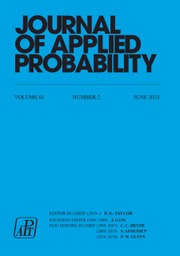Crossref Citations
This article has been cited by the following publications. This list is generated based on data provided by
Crossref.
Henderson, W.
and
Taylor, P. G.
1992.
Discrete-time queueing networks with geometric release probabilities.
Advances in Applied Probability,
Vol. 24,
Issue. 01,
p.
229.
Coleman, J.L.
1993.
Algorithms for product-form stochastic Petri nets-A new approach.
p.
108.
Balbo, G.
Bruell, S. C.
and
Sereno, M.
1994.
Arrival theorems for product-form stochastic Petri nets.
ACM SIGMETRICS Performance Evaluation Review,
Vol. 22,
Issue. 1,
p.
87.
Ōsawa, Hideo
1994.
Quasi-reversibility of a discrete-time queue and related models.
Queueing Systems,
Vol. 18,
Issue. 1-2,
p.
133.
Balbo, G.
Bruell, S. C.
and
Sereno, M.
1994.
Arrival theorems for product-form stochastic Petri nets.
p.
87.
Coyle, A. J.
Henderson, W.
Pearce, C. E. M.
and
Taylor, P. G.
1994.
A general formulation for mean-value analysis in product-form batch-movement queueing networks.
Queueing Systems,
Vol. 16,
Issue. 3-4,
p.
363.
Miyazawa, Masakiyo
1994.
On the characterization of departure rules for discrete-time queueing networks with batch movements and its applications.
Queueing Systems,
Vol. 18,
Issue. 1-2,
p.
149.
Henderson, W.
Northcote, B. S.
and
Taylor, P. G.
1995.
Triggered batch movement in queueing networks.
Queueing Systems,
Vol. 21,
Issue. 1-2,
p.
125.
Harnpanichpun, Niruhn
and
Pujolle, Guy
1995.
Product-form discrete-time queues in series with batch transition: late arrival case.
Performance Evaluation,
Vol. 21,
Issue. 3,
p.
261.
Pujolle, G.
1995.
Product form in discrete-time queueing networks: new issues.
p.
148.
Coyle, A.J.
Henderson, W.
Pearce, C.E.M.
and
Taylor, P.G.
1995.
Mean-value analysis for a class of Petri nets and batch-movement queueing networks with product-form equilibrium distributions.
Mathematical and Computer Modelling,
Vol. 22,
Issue. 10-12,
p.
27.
Coleman, J.L.
Henderson, W.
and
Taylor, P.G.
1996.
Product form equilibrium distributions and a convolution algorithm for stochastic Petri nets.
Performance Evaluation,
Vol. 26,
Issue. 3,
p.
159.
Daduna, Hans
1996.
The cycle time distribution in a cycle of Bernoulli servers in discrete time.
Mathematical Methods of Operations Research,
Vol. 44,
Issue. 3,
p.
295.
Miyazawa, Masakiyo
1997.
Structure-reversibility and departure functions of queueing networks with batch movements and state dependent routing.
Queueing Systems,
Vol. 25,
Issue. 1-4,
p.
45.
Boucherie, Richard J.
and
van Dijk, Nico M.
1997.
On the arrivai theorem for product form queueing networks with blocking.
Performance Evaluation,
Vol. 29,
Issue. 3,
p.
155.
Coleman, J. L.
Henderson, W.
Pearce, C. E. M.
and
Taylor, P. G.
1997.
A correspondence between product-form batch-movement queueing networks and single-movement networks.
Journal of Applied Probability,
Vol. 34,
Issue. 01,
p.
160.
Daduna, Hans
1997.
Some results for steady-state and sojourn time distributions in open and closed linear networks of Bernoulli servers with state-dependent service and arrival rates.
Performance Evaluation,
Vol. 30,
Issue. 1-2,
p.
3.
Miyazawa, Masakiyo
and
Taylor, Peter G.
1997.
A Geometric Product-Form Distribution for a Queueing Network by Non-Standard Batch Arrivals and Batch Transfers.
Advances in Applied Probability,
Vol. 29,
Issue. 02,
p.
523.
Boucherie, Richard J.
and
Sereno, Matteo
1998.
On closed support T-Invariants and the traffic equations.
Journal of Applied Probability,
Vol. 35,
Issue. 02,
p.
473.
Boucherie, Richard J.
1998.
On the arrival theorem for queueing networks operating under a just-in-time protocol.
Performance Evaluation,
Vol. 34,
Issue. 2,
p.
109.

